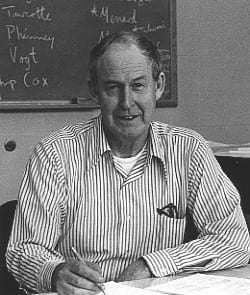John I. Ewing
The Woods Hole Oceanographic Institution announces with great sorrow the death November 15, 2001, of Scientist Emeritus John I. Ewing at the Royal Nursing & Alzheimer’s Center in Falmouth after a long illness. He was 77.
John Isaac Ewing was born July 5, 1924, in Lockney, Texas. His long relationship with the Institution began in 1941when, just out of high school at age 17, older brother Maurice asked him to leave Texas and come to Woods Hole to work with him at the Institution. The following year John made his first cruise aboard the Anton Dohrn to photograph a sunken German submarine off the coast of North Carolina. After what John often described as “one glorious year” at WHOI, Maurice sent him to college at Harvard. Service in the U.S. Army Air Force as a Corporal interrupted his undergraduate studies between 1943 and 1945, but after the war John returned to school and received his B.S. degree in physics from Harvard College in 1950. After graduation he began a long and distinguished career in marine geophysical research, joining his brother and the staff at Lamont Doherty Geological Observatory of Columbia University in 1950 as a research assistant and later holding positions as Research Associate and Senior Research Associate. In 1973 he was named Associate Director of Research at Lamont, and from 1975 to 1981 was Adjunct Professor of Geology at Columbia University. During his career he served as chief scientist on many cruises, including trips aboard Research Vessels Atlantis, Caryn, Vema, Sir Horace Lamb, Crawford and the Glomar Challenger.
In 1976, John Ewing returned to Woods Hole and joined the Institution staff as Senior Scientist and Chairman of the Department of Geology and Geophysics. Considered a world leader in marine seismology and an innovator in the use of new technologies, John Ewing was a gentleman who preferred to quietly pursue new directions in ocean sciences. His colleagues valued his experience, respected his advice and intellectual curiosity, and admired his leadership and numerous scientific contributions. “He covered an amazingly wide area of fundamentals to visualize, understand, and model underneath the ocean floor, abyssal plains, ridges, and the continental slopes of the world’s oceans,” one colleague wrote. “He was the scientist who originally introduced fully pledged, active seismology to the academic domain. Without him, this noble technology, now standard in oceanography, would have stayed within industry and the oceanic structure would never have been so well understood as it is today.” He was the author or co-author of more than 100 publications in marine geology and geophysics, many on crustal and continental margin structure, and his works have influenced scientists worldwide.
Considered the inventor of the air gun as a sound source for marine seismology, John Ewing used air guns to study the structure of sediments and oceanic crust around the world. He was the first person to put a microphone into a hole in the seafloor, and he was instrumental in innovative uses of multichannel seismic systems in such programs as the Large Aperture Seismic Experiment (LASE) and Rivera Ocean Seismic Experiment (ROSE). In addition to his scientific accomplishments, John Ewing was also admired for his organizational and administrative skills, his wisdom and experience, his ability to deal with diverse personalities, and his gracious, gentle spirit.
He took a leave of absence in 1982 to work with the Gulf Oil Company’s Research Group at Pearl River, NY, returning to WHOI in 1983. He was named head of the Ocean Industry Program in 1984. For many years he was also affiliated with the Houston Advanced Research Center in The Woodlands, Texas, conducting deep crustal structure research. He served as a member of many Joint Oceanographic Institutions for Deep Earth Sampling (JOIDES) committees and was chair of the JOIDES Planning Committee from 1975 to 1977 and again from 1979 to 1980. He retired from WHOI in 1989 and was named Scientist Emeritus that same year.
During his career John Ewing received numerous honors and awards, among them the SEPM Francis P. Shepard Medal in 1976, and the Maurice Ewing Medal from the American Geophysical Union (AGU) in 1982. He was a Fellow of the American Geophysical Union and of the American Association for the Advancement of Science (AAAS), and was a member of numerous professional organizations and societies, including the Society of Exploration Geophysicists, AGU and AAAS.
He is survived by his wife, Ellen “Betty” (Thomas) Ewing of Falmouth, a daughter, Martha Ewing of Boston, MA; a son, John Ewing, and his wife Melinda of Norwell, MA; two grandchildren, Andrew and Julia Ewing of Norwell, MA; a brother, Ret/ USN Capt. Robert Ewing of Fair oaks Ranch, TX; and several nieces and nephews. Another daughter, Valerie Ewing-Sprague, died in 1996.
Burial is private. Donations in John Ewing’s memory may be made to the Harvard Brain Tissue Resource Center, McLean Hospital, 115 Mill Street, Belmont, MA 02178, or to the charity of one’s choice.

